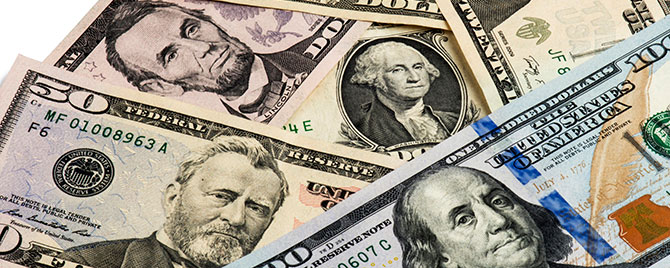1. A Living Person May Not Appear on U.S. Currency
Ever heard U.S. currency called “dead presidents?” To avoid the appearance of a monarchy, it was long-standing tradition to only feature portraits of deceased individuals on currency and coin. That tradition became law with an 1866 Act of Congress.
2. Washington Is the Longest Running Dead President
The federal government still officially calls President’s Day “Washington’s Birthday”; and George Washington’s portrait has graced the $1 note for nearly 150 years. The $1 note is the oldest U.S. currency produced today.
3. Number 13 Also Stars on the Mystical Dollar
The dollar is by far the most intriguing note. It’s known for its mystic symbols, including the prevalence of the number 13, which symbolizes the original American colonies. You’ll find 13 stars above the eagle, and the top of the shield has 13 horizontal stripes. How many more instances of 13 can you find?
4. The $50 Note is Often Called a “Grant”
The $50 “Grant” features a portrait of Ulysses S. Grant, the Union General who won defining Civil War battles and went on to lead the country. President Grant was also responsible for the passage of the 15th Amendment, which states that voting rights cannot be restricted based on a person’s race.
5. But No Need to be a President to Appear on a Note
The portraits currently appearing on U.S. currency were adopted in 1928 when the size of notes was reduced to the format we know today. The Treasury determined that presidents have a permanent familiarity in the minds of the public, but they didn’t forget a few other notable historic figures. Among those is Benjamin Franklin, one of the signers of the Declaration of Independence.
6. In Fact, You Won’t Find a President on the Highest Denomination Ever Circulated
The $100 note is the highest denomination produced today but, before 1969, you could ask your bank teller for a $10,000 note. In spite of its value, it is adorned not with a portrait of a president, but with that of Salmon P. Chase, the Secretary of the Treasury during the Civil War who is credited with the passing of the National Banking Act, which created our National Banking System. The Treasury stopped producing the $10,000 note in 1969.
7. But You Will Find a President on the Highest Denomination Ever Printed
Contrary to what you may have heard, the Treasury has never issued a $1 million note. The largest note ever printed was the $100,000 Gold Certificate printed between December 1934 and January 1935. The note featured a portrait of President Woodrow Wilson, the founder of the Federal Reserve System. But don’t ask your bank teller for a $100,000 note. They never circulated to the public and were used solely for transactions among Federal Reserve Banks.
You may also want to read:
The views expressed here do not necessarily reflect the views of the management of the Federal Reserve Bank of San Francisco or of the Board of Governors of the Federal Reserve System.
